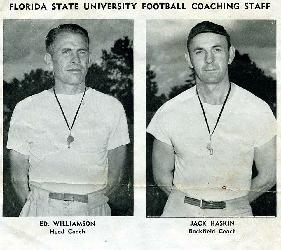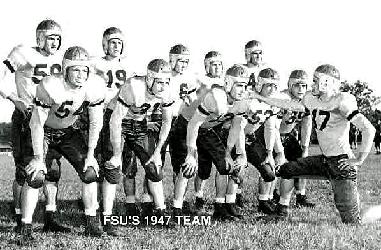
Sixty Years Ago
By Jim Joanos
Sixty years ago the leadership of Florida State University decided to revive the school's participation in intercollegiate football. Back in 1902 through 1904 when the institution was named "Florida State College" it had fielded a football team, a good one at that. The 1904 team had even won the mythical state championship and been awarded the Florida Times Union's "College Cup" trophy for that accomplishment, which included victories over the University of Florida at Lake City, and Stetson. However, in 1905 that team was disbanded when the legislature converted Florida State into a women's only college. The school remained a women's college until 1947 following World War II when it again became coeducational in order to help accommodate the GI's who had put down their weapons, returned to civilian life, and wished to continue their educations.
In today's world, the beginning of a college football program would require a great deal of discussion, planning, and preparation. However, in 1947, the powers that were got together, decided to do it, selected a coach and began the program. It was just about that simple.
 |
The coach that was selected to start the program was a man named Ed Williamson who had been hired by FSU as a physical education instructor. Williamson had been raised in Tallahassee and played college football at the University of Florida. His only football coaching experience had been at the high school level. Williamson was assigned one assistant coach, another physical education instructor, Jack Haskin. Haskin would later become the founder of the FSU Flying High Circus. With these two men in charge, word was then sent out that there would be a team. From somewhere, a supply of football shoes were acquired and distributed to the students who responded to the call. There were not enough shoes for all those who wanted to participate.
In September of 1947, the first team meeting took place. There were about 65 potential players there. Most of them were military veterans. Plans were outlined by the coaches. Williamson would coach the linemen while Haskin would work with the backs. Soon they began preparing for the first game. Players were matched up with the positions that needed to be filled. On October 11, a game like "East-West scrimmage" was held at night under lights and about 3,000 fans showed up to watch it.
 |
Tallahassee's Centennial Field was the site of the first game which was played on the night of October 18, 1947. It was ironic that Stetson University of Deland was the opponent for the new team's first game as that was the last team that Florida State played in 1904 before the school was converted into an all women's institution. Although the bleachers would accommodate only about 6,000, there were nearly 8,000 fans packed in for that first game. FSU won the coin toss and received the opening kickoff. The first scoring took place in the second quarter when FSU quarterback Don Grant of Perry passed to end Charles McMillan of Quincy for a touchdown. Although FSU scored first, they lost the game to Stetson, 14-6.
Between the first and second game of that 1947 season, the Florida State team got a name. The name selected was "Seminoles" in honor of the native Americans who had fought valiantly to retain their presence in Florida and refused to surrender to the powerful United State military forces. There are conflicting stories about how the name was selected but nearly all accounts indicate that a vote was taken by the student body. In any event, that name has been proudly utilized by all FSU athletic teams since.
FSU played four more games that year but lost all of them against Cumberland College, Tennessee Tech, Troy State, and Jacksonville State of Alabama. Although FSU did not win a game that first season, it had not been embarrassed in any of them.
In the sixty years since that modest beginning, the FSU football program has accomplished a lot. There were no last year's starters and no lettermen on that first team. There were no athletic scholarships. No special benefits. From that humble beginning has emerged one of the great programs of modern day college football. The record includes two national championships, fourteen consecutive seasons (1987 through 2000) finishing among the top five teams in the country, twelve Atlantic Coast Conference championships, and twenty-one post season bowl game victories. It has been a glorious trip that began with a team made up mostly of World War II veterans. As the 2007 team soon will gather to embark upon the 61st season, we wish them good luck and hope that they will have another good year.